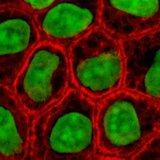Cell (biology)
|
|
The cell is the structural and functional unit of all living organisms, sometimes called the "building blocks of life." Some organisms, such as bacteria, are unicellular, consisting of a single cell. Other organisms, such as humans, are multicellular, (humans have an estimated 100,000 billion = 1014 cells). The cell theory, first developed in the 19th century, states that all organisms are composed of one or more cells; all cells come from preexisting cells; all vital functions of an organism occur within cells and that cells contain the hereditary information necessary for regulating cell functions and for transmitting information to the next generation of cells.
The word cell comes from the Latin cella, a small room. The name was chosen by Robert Hooke because of the likeness he saw between cork cells and small rooms.
| Contents |
Overview
Properties of cells
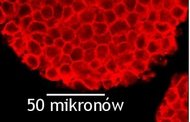
Each cell is at least somewhat self-contained and self-maintaining: it can take in nutrients, convert these nutrients into energy, carry out specialized functions, and reproduce as necessary. Each cell stores its own set of instructions for carrying out each of these activities.
All cells share several abilities:
- Reproduction by cell division.
- Metabolism, including taking in raw materials, building cell components, creating energy molecules and releasing by-products. The functioning of a cell depends upon its ability to extract and use chemical energy stored in organic molecules. This energy is derived from metabolic pathways.
- Synthesis of proteins, the functional workhorses of cells, such as enzymes. A typical mammalian cell contains up to 10,000 different proteins.
- Response to external and internal stimuli such as changes in temperature, pH or nutrient levels.
- Traffic of vesicles.
Types of cells
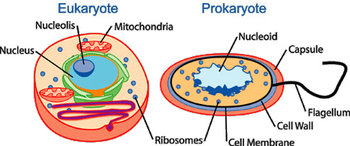
One way to classify cells is whether they live alone or in groups. Organisms vary from single cells (called single-celled or unicellular organisms) that function and survive more or less independently, through colonial forms with cells living together, to multicellular forms in which cells are specialized. 220 types of cells and tissues make up the multicellular human body.
Cells can also be classified into two categories based on their internal structure.
- Prokaryotic cells are structurally simple. They are found only in single-celled and colonial organisms. In the three-domain system of scientific classification, prokaryotic cells are placed in the domains Archaea and Eubacteria.
- Eukaryotic cells have organelles with their own membranes. Single-celled eukaryotic organisms such as amoebae and some fungi are very diverse, but many colonial and multicellular forms such as plants, animals, and brown algae also exist.
Components of cells
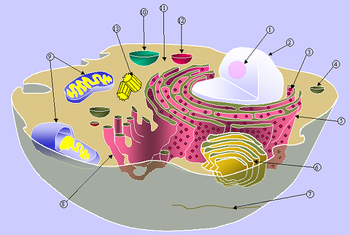
Plant_cell_structure.png
All cells whether prokaryotic or eukaryotic have a membrane, which envelopes the cell, separates its interior from the surroundings, controls what moves in and out, and maintains the electric potential of the cell. Inside the membrane, a salty cytoplasm takes up most of the cell volume. All cells possess DNA, the hereditary material of genes, and RNA, which contain the information necessary to build various proteins such as enzymes, the cell's primary machinery. There are also other kinds of biomolecules in cells. This article will list these primary components of the cell then briefly describe their function.
Cell membrane - a cell's protective coat
Main article: Cell membrane
The cytoplasm of a eukaryotic cell is surrounded by a plasma membrane. A form of plasma membrane is also found in prokaryotes, but is usually referred to as the cell membrane. This membrane serves to separate and protect a cell from its surrounding environment and is made mostly from a double layer of lipids (fat-like molecules) and proteins. Embedded within this membrane are a variety of other molecules that act as channels and pumps, moving different molecules into and out of the cell.
Cytoskeleton - a cell's scaffold
Main article: Cytoskeleton
The cytoskeleton is an important, complex, and dynamic cell component. It acts to organize and maintain the cell's shape; anchors organelles in place; helps during endocytosis, the uptake of external materials by a cell; and moves parts of the cell in processes of growth and motility. There are a great number of proteins associated with the cytoskeleton, each controlling a cell's structure by directing, bundling, and aligning filaments.
Cytoplasm - a cell's inner space
Main article: Cytoplasm
Inside the cell there is a large fluid-filled space called the cytoplasm, which includes both to the mixture of ions and fluids in solution within the cell, and to the organelles contained in it. The term cytosol refers only to the fluid itself.
In prokaryotes, the cytoplasm is relatively free of compartments. In eukaryotes, it normally contains a large number of organelles. The cytosol contains dissolved nutrients, helps break down waste products, and moves material around the cell through a process called cytoplasmic streaming. The nucleus often flows with the cytoplasm, changing its shape as it moves. The cytoplasm also contains many salts and is an excellent conductor of electricity, which is important in certain cell functions like cell signaling.
Genetic material
Two different kinds of genetic material exist: deoxyribonucleic acid (DNA) and ribonucleic acid (RNA). Most organisms use DNA for their long term information storage, but some viruses (retroviruses) have RNA as their genetic material. The biological information contained in an organism is encoded in its DNA or RNA sequence. RNA is also used for information transport (e.g. mRNA) and enzymatic functions (e.g. ribosomal RNA) in organisms that use DNA for the genetic code itself.
Prokaryotic genetic material is organized in a simple circular DNA molecule (the bacterial chromosome) in the nucleoid region of the cytoplasm. Eukaryotic genetic material is divided into different, linear molecules called chromosomes inside a discrete nucleus, usually with additional genetic material in some organelles like mitochondria and chloroplasts (see endosymbiotic theory).
A human cell, for example, has genetic material in the nucleus (the nuclear genome) and in the mitochondria (the mitochondrial genome). The nuclear genome is divided into 46 linear DNA molecules called chromosomes. The mitochondrial genome is a circular DNA molecule separate from the nuclear DNA. Although the mitochondrial genome is very small, it codes for some important proteins.
Organelles
Main article: Organelle
The human body contains many different organs, such as the heart, lung, and kidney, with each organ performing a different function. Cells also have a set of "little organs", called organelles, that are adapted and/or specialized for carrying out one or more vital functions. Organelles are found only in eukaryotes and are, with a few exceptions, surrounded by a protective membrane.
- Cell nucleus - a cell's information center: The cell nucleus is the most conspicuous organelle found in a eukaryotic cell. It houses the cell's chromosomes and is the place where almost all DNA replication and RNA synthesis occur. The nucleus is spheroid in shape and separated from the cytoplasm by a double membrane called the nuclear envelope. The nuclear envelope isolates and protects a cell's DNA from various molecules that could accidentally damage its structure or interfere with its processing. During processing, DNA is transcribed, or copied into a special RNA, called mRNA. This mRNA is then transported out of the nucleus, where it is translated into a specific protein molecule. In prokaryotes, DNA processing takes place in the cytoplasm.
- Ribosomes - the protein production machine: Ribosomes are found in both prokaryotes and eukaryotes. The ribosome is a large complex composed of many molecules, including RNAs and proteins, and is responsible for processing the genetic instructions carried by an mRNA. The process of converting an mRNA's genetic code into the exact sequence of amino acids that make up a protein is called translation. Protein synthesis is extremely important to all cells, and therefore a large number of ribosomes—sometimes hundreds or even thousands—can be found throughout a cell.
- Mitochondria and chloroplasts - the power generators: Mitochondria are self-replicating organelles that occur in various numbers, shapes, and sizes in the cytoplasm of all eukaryotic cells. As mentioned earlier, mitochondria contain their own genome that is separate and distinct from the nuclear genome of a cell. Mitochondria play a critical role in generating energy in the eukaryotic cell, and this process involves a number of complex metabolic pathways. Chloroplasts are larger than mitochondria, and convert solar energy into a chemical energy ("food") via photosynthesis. Like mitochondria, chloroplasts have their own genome. Chloroplasts and are found only in photosynthetic eukaryotes like plants and algae. There are a number of plant organelles that are modified chloroplasts; they are broadly called plastids and are often involved in storage.
- Endoplasmic reticulum and Golgi apparatus - macromolecule managers:: The endoplasmic reticulum (ER) is the transport network for molecules targeted for certain modifications and specific destinations, as compared to molecules that will float freely in the cytoplasm. The ER has two forms: the rough ER, which has ribosomes on its surface, and the smooth ER, which lacks them. Translation of the mRNA for those proteins that will either stay in the ER or be exported from the cell occurs at the ribosomes attached to the rough ER. The smooth ER is important in lipid synthesis, detoxification and as a calcium reservoir. The Golgi apparatus, sometimes called a Golgi body or Golgi complex is the entral delivery system for the cell and is a site for protein processing, packaging, and transport. Both organelles consist largely of heavily folded membranes.
- Lysosomes and peroxisomes - the cellular digestive system: Lysosomes and peroxisomes are often referred to as the garbage disposal system of a cell. Both organelles are somewhat spherical, bound by a single membrane, and rich in digestive enzymes, naturally occurring proteins that speed up biochemical processes. For example, lysosomes can contain more than three dozen enzymes for degrading proteins, nucleic acids, and certain sugars called polysaccharides. Here we can see the importance behind compartmentalization of the eukaryotic cell. The cell could not house such destructive enzymes if they were not contained in a membrane-bound system.
Anatomy of cells
Prokaryotic cells
Prokaryotes are distinguished from eukaryotes on the basis of nuclear organization, specifically their lack of a nuclear membrane. Prokaryotes also lack most of the intracellular organelles and structures that are characteristic of eukaryotic cells (an important exception is the ribosomes, which are present in both prokaryotic and eukaryotic cells). Most of the functions of organelles, such as mitochondria, chloroplasts, and the Golgi apparatus, are taken over by the prokaryotic plasma membrane. Prokaryotic cells have three architectural regions: appendages called flagella and pili—proteins attached to the cell surface; a cell envelope consisting of a capsule, a cell wall, and a plasma membrane; and a cytoplasmic region that contains the cell genome (DNA) and ribosomes and various sorts of inclusions. Other differences include:
- The plasma membrane (a phospholipid bilayer) separates the interior of the cell from its environment and serves as a filter and communications beacon.
- Most prokaryotes have a cell wall (some exceptions are Mycoplasma (a bacterium) and Thermoplasma (an archaeon)). It consists of peptidoglycan in bacteria, and acts as an additional barrier against exterior forces. It also prevents the cell from "exploding" from osmotic pressure against a hypotonic environment. A cell wall is also present in some eukaryotes like fungi, but has a different chemical composition
- A prokaryotic chromosome is usually a circular molecule (an exception is that of the bacterium Borrelia burgdorferi, which causes Lyme disease). Even without a real nucleus, the DNA is condensed in a nucleoid. Prokaryotes can carry extrachromosomal DNA elements called plasmids, which are usually circular. Plasmids can carry additional functions, such as antibiotic resistance.
Eukaryotic cells
Eukaryotic cells are about 10 times the size of a typical prokaryote and can be as much as 1000 times greater in volume. The major difference between prokaryotes and eukaryotes is that eukaryotic cells contain membrane-bound compartments in which specific metabolic activities take place. Most important among these is the presence of a nucleus, a membrane-delineated compartment that houses the eukaryotic cell's DNA. It is this nucleus that gives the eukaryote its name, which means "true nucleus". Other differences include:
- The plasma membrane resembles that of prokaryotes in function, with minor differences in the setup. Cell walls may or may not be present.
- The eukaryotic DNA is organized in one or more linear molecules, called chromosomes, which are highly condensed (i.e. folded around histones). All chromosomal DNA is stored in the cell nucleus, separated from the cytoplasm by a membrane. Some eukaryotic organelles can contain some DNA.
- Eukaryotes can move using cilia or flagella. The flagella are more complex than those of prokaryotes.
| Prokaryotes | Eukaryotes | |
|---|---|---|
| Typical organisms | bacteria, archaea | protists, fungi, plants, animals |
| Typical size | ~ 1-10 ?m | ~ 10-100 ?m (sperm cells, apart from the tail, are smaller) |
| Type of nucleus | nucleoid region; no real nucleus | real nucleus with double membrane |
| DNA | circular (usually) | linear molecules (chromosomes) with histone proteins |
| RNA-/protein-synthesis | coupled in cytoplasm | RNA-synthesis inside the nucleus protein synthesis in cytoplasm |
| Ribosomes | 50S+30S | 60S+40S |
| Cytoplasmatic structure | very few structures | highly structured by endomembranes and a cytoskeleton |
| Cell movement | flagella made of flagellin | flagella and cilia made of tubulin |
| Mitochondria | none | one to several dozen (though some lack mitochondria) |
| Chloroplasts | none | in algae and plants |
| Organization | usually single cells | single cells, colonies, higher multicellular organisms with specialized cells |
| Cell division | Binary fission (simple division) | Mitosis Meiosis |
| Typical animal cell | Typical plant cell | |
|---|---|---|
| Organelles |
|
|
| Additional structures |
|
Cell functions
Cell growth and metabolism
Main articles: Cell growth, Cell metabolism
Between successive cell divisions cells grow through the functioning of cellular metabolism. Cell metabolism is the process by which individual cells process nutrient molecules. Metabolism has two distinct divisions; catabolism, in which the cell breaks down complex molecules to produce energy and reducing power, and anabolism, where the cell uses energy and reducing power to construct complex molecules and perform other biological functions. Complex sugars consumed by the organism can be broken down into a less chemically complex sugar molecule called glucose. Once inside the cell, glucose is broken down to make adenosine triphosphate (ATP), a form of energy, via two different pathways.
The first pathway, glycolysis, requires no oxygen and is referred to as anaerobic metabolism. Each reaction is designed to produce some hydrogen ions that can then be used to make energy packets (ATP). In prokaryotes, glycolysis is the only method used for converting energy. The second pathway, called the Kreb's cycle, or citric acid cycle, occurs inside the mitochondria and is capable of generating enough ATP to run all the cell functions.
Making new cells
Main article: Cell division
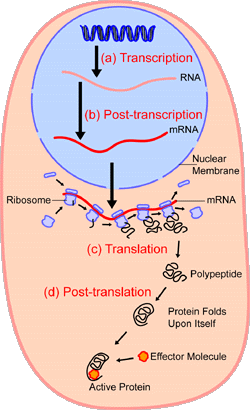
Within the nucleus of the cell (light blue), genes (DNA, dark blue) are transcribed into RNA. This RNA is then subject to post-transcriptional modification and control, resulting in a mature mRNA (red) that is then transported out of the nucleus and into the cytoplasm (peach), where it undergoes translation into a protein. mRNA is translated by ribosomes (purple) that match the three-base codons of the mRNA to the three-base anti-codons of the appropriate tRNA. Newly synthesized proteins (black) are often further modified, such as by binding to an effector molecule (orange), to become fully active.
Cell division involves a single cell (called a mother cell) dividing into two daughter cells. This leads to growth in multicellular organisms (the growth of tissue) and to procreation (vegetative reproduction) in unicellular organisms. Prokaryotic cells divide by binary fission. Eukaryotic cells usually undergo a process of nuclear division, called mitosis, followed by division of the cell, called cytokinesis. A diploid cell may also undergo meiosis to produce haploid cells, usually four. Haploid cells serve as gametes in multicellular organisms, fusing to form new diploid cells. DNA replication, or the process of duplicating a cell's genome, is required every time a cell divides. Replication, like all cellular activities, requires specialized proteins for carrying out the job.
Protein synthesis
Main article: Protein biosynthesis
Protein synthesis is the process in which the cell builds proteins. DNA transcription refers to the synthesis of a messenger RNA (mRNA) molecule from a DNA template. This process is very similar to DNA replication. Once the mRNA has been generated, a new protein molecule is synthesized via the process of translation.
The cellular machinery responsible for synthesizing proteins is the ribosome. The ribosome consists of structural RNA and about 80 different proteins. When the ribosome encounters an mRNA, the process of translating an mRNA to a protein begins. The ribosome accepts a new transfer RNA, or tRNA—the adaptor molecule that acts as a translator between mRNA and protein—bearing an amino acid, the building block of the protein. Another site binds the tRNA that becomes attached to the growing chain of amino acids, forming the a polypeptide chain that will eventually be processed to become a protein.
Origins of cells
Main article: Origin of life
The origin of cells has to do with the origin of life, and was one of the most important steps in evolution of life as we know it. The birth of the cell marked the passage from prebiotic chemistry to biological life.
Origin of first cell
If life is viewed from the point of view of replicators, that is DNA molecules in the organism, cells satisfy two fundamental conditions: protection from the outside environment and confinement of biochemical activity. The former condition is needed to maintain the fragile DNA chains stable in a varying and sometimes aggressive environment, and may have been the main reason for which cells evolved. The latter is fundamental for the evolution of biological complexity. If freely-floating DNA molecules that code for enzymes that are not enclosed into cells, the enzymes that advantage a given DNA molecule (for example, by producing nucleotides) will automatically advantage the neighbouring DNA molecules. This might be viewed as "parasitism by default". Therefore the selection pressure on DNA molecules will be much lower, since there is not a definitive advantage for the "lucky" DNA molecule that produces the better enzyme over the others: all molecules in a given neighbourhood are almost equally advantaged.
If all the DNA molecule is enclosed in a cell, then the enzymes coded from the molecule will be kept close to the DNA molecule itself. The DNA molecule will directly enjoy the benefits of the enzymes it codes, and not of others. This means other DNA molecules won't benefit from a positive mutation in a neighbouring molecule: this in turn means that positive mutations give immediate and selective advantage to the replicator bearing it, and not on others. This is thought to have been the one of the main driving force of evolution of life as we know it. (Note. This is more a metaphor given for simplicity than complete accuracy, since the earliest molecules of life, probably up to the stage of cellular life, were most likely RNA molecules, acting both as replicators and enzymes: see RNA world hypothesis . But the core of the reasoning is the same.)
Biochemically, cell-like spheroids formed by proteinoids are observed by heating amino acids with phosphoric acid as a catalyst. They bear much of the basic features provided by cell membranes. Proteinoid-based protocells enclosing RNA molecules could (but not necessarily should) have been the first cellular life forms on Earth.
Origin of eukaryotic cells
The eukaryotic cell seems to have evolved from a symbiotic community of prokaryotic cells. It is almost certain that DNA-bearing organelles like the mitochondria and the chloroplasts are what remains of ancient symbiotic oxygen-breathing bacteria and cyanobacteria, respectively, where the rest of the cell seems to be derived from an ancestral archaean prokaryote cell – a theory termed the endosymbiotic theory.
There is still considerable debate on if organelles like the hydrogenosome predated the origin of mitochondria, or viceversa : see the hydrogen hypothesis for the origin of eukaryotic cells.
History
- 1632-1723: Antony van Leeuwenhoek teaches himself to grind lenses, builds a microscope and draws protozoa, such as Vorticella from rain water, and bacteria from his own mouth.
- 1665 : Robert Hooke discovers cells in cork, then in living plant tissue using an early microscope.
- ...I could exceedingly plainly perceive it to be all perforated and porous, much like a Honeycomb...these pores or cells, were not very deep, but consisted of a great many little boxes... – Hooke describing his observations on a thin slice of cork.
- 1839 : Theodor Schwann and Matthias Jakob Schleiden elucidate the principal that plants and animals are made of cells, concluding that cells are a common unit of structure and development, thus founding the Cell Theory.
- The belief that life forms are able to occur spontaneously (generatio spontanea) is contradicted by Louis Pasteur (1822-1895).
- Rudolph Virchow states that cells always emerge from cell divisions (omnis cellula ex cellula).
- 1931: Ernst Ruska builds first transmission electron microscope (TEM) at the University of Berlin. By 1935 he has built an EM with twice the resolution of a light microscope, revealing previously unresolvable organelles.
- 1953: Watson and Crick made their first announcement on the double-helix structure for DNA on February 28.
- 1981: Lynn Margulis published Symbiosis in Cell Evolution detailing the endosymbiotic theory.

